Mastering Brutalist Kitchen Design: A Comprehensive Guide to Raw Elegance and Industrial Style
Tired of kitchens that feel ordinary and lack distinct character? If you’re seeking a bold, unique, and profoundly individual statement for your home, then the brutalist kitchen style, often paired with minimalist touches, might be the perfect architectural inspiration you’ve been searching for. This design philosophy goes beyond mere aesthetics, championing authenticity and robust functionality.
This comprehensive guide will walk you through the exciting world of brutalist kitchen design, showing you how to harness the power of concrete, raw metals, natural stone, and clean lines. The result is a kitchen space that is both strikingly dramatic and incredibly functional, a true testament to modern, unadorned beauty.
Whether you’re planning a complete renovation of your existing space or starting fresh with a new build, we’ll provide you with the insights and inspiration needed to infuse this commanding style into the heart of your home. Get ready to transform your kitchen into an extraordinary masterpiece that reflects strength, honesty, and sophisticated simplicity!
What is a Brutalist Kitchen?
A brutalist kitchen draws its profound inspiration from the brutalist architectural movement, which emerged in the mid-20th century. Known for its raw, industrial, and often monumental aesthetic, Brutalism celebrates the inherent beauty of exposed construction materials. In a brutalist kitchen, this translates into a design ethos that prioritizes simplicity, honesty, and uncompromising practicality, often utilizing materials in their most unrefined states.
The core philosophy revolves around exposing the structural elements and raw texture of materials such as concrete (from the French “béton brut,” meaning “raw concrete”), steel, and natural stone. Decoration is secondary to utility; instead, the materials themselves become the decoration. The design emphasizes clean lines, bold geometric shapes, and a commanding presence. In such a kitchen, you’ll typically encounter distinctive features like robust concrete countertops, visible steel fixtures, and sometimes unadorned brick or stone walls that showcase their natural textures.
Brutalist kitchens are inherently minimalistic, intentionally avoiding excessive ornamentation or clutter. The color palette is almost exclusively muted, relying on a spectrum of greys, deep blacks, and natural earthy tones derived directly from the chosen materials. This understated color scheme allows the textures and forms of the raw materials to take center stage, creating a tactile and visually rich environment without being overtly colorful.
In a brutalist kitchen, the materials are not just components; they are the main focus, revered for their intrinsic beauty and structural integrity. Exposed steel cabinets, oversized industrial light fixtures, and open shelving systems contribute significantly to the overall industrial and unpolished feel. This style transcends mere visual appeal; it’s about crafting a space that is profoundly practical, remarkably durable, and unequivocally honest in its construction and form.
Ultimately, a brutalist kitchen offers a bold, uncompromising, and inherently simple design solution. It is an ideal choice for individuals who desire a highly functional, minimalist kitchen with a strong industrial identity, celebrating the raw power and understated elegance of foundational building elements.
Essential Elements of a Brutalist Kitchen
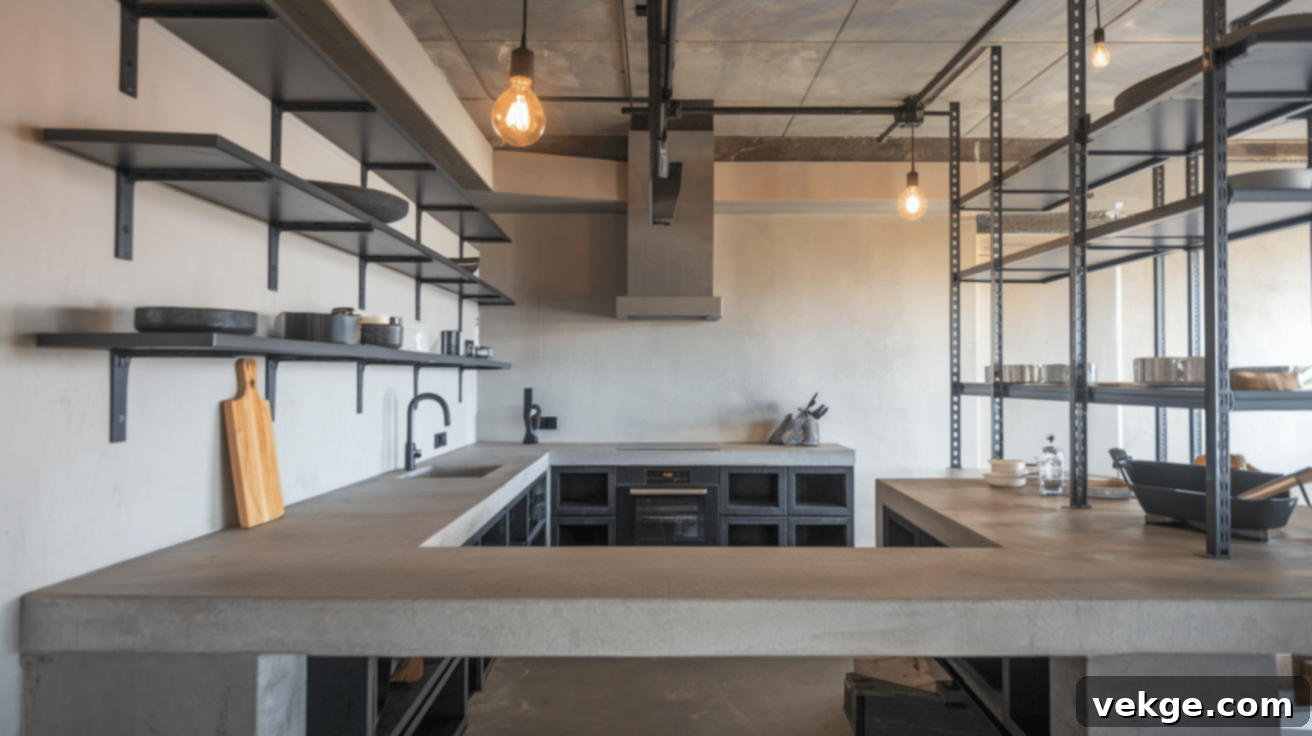
To truly achieve the distinctive look and feel of a brutalist kitchen, understanding its core components is crucial. This style masterfully uses raw materials and straightforward designs to forge a bold, industrial aesthetic that is both impactful and functional. Here are the key features that define this striking design:
Concrete Countertops
Concrete countertops are perhaps the most iconic feature of a brutalist kitchen, instantly imparting a strong, unapologetically raw, and robust appearance. Their appeal lies not just in their aesthetic but also in their practicality: they are incredibly durable, remarkably easy to clean, and perfectly align with the minimalist ethos of brutalist design. The inherently plain, often unfinished or subtly textured surface of concrete creates a modern, almost sculptural feel, providing a tough yet functional workspace for everyday culinary tasks. Concrete can be poured in situ or prefabricated, offering incredible versatility in shape and size, and can be sealed to protect against stains, enhancing its longevity.
Exposed Steel and Metal Elements
Steel and other metals are indispensable in brutalist kitchens, contributing significantly to their signature industrial character. You’ll frequently encounter metal elements in various forms, such as sleek stainless steel or blackened steel cabinets, robust open shelving, industrial-grade appliances, and exposed structural components. These metallic features not only enhance the kitchen’s urban and modern vibe but also introduce a sense of enduring strength and longevity. Steel, renowned for its exceptional durability and hygienic properties, is an excellent choice for high-traffic fixtures and major appliances, providing both resilience and a contemporary edge.
Minimalist Cabinetry
In a brutalist kitchen, cabinetry is designed with utmost simplicity and functionality in mind. The focus is on clean, uninterrupted lines, blocky forms, and a complete absence of decorative hardware or elaborate details. Often, cabinets feature flat panels with integrated handles or push-to-open mechanisms to maintain a seamless appearance. Floating shelves, often crafted from steel or thick concrete, are favored over traditional upper cabinets to keep the space visually open, light, and airy, allowing the raw wall textures to come through. The overarching goal is to maintain a practical, clutter-free environment, where every element serves a purpose without unnecessary embellishment.
Industrial Lighting
Industrial light fixtures are a crucial component that contributes to the authentic character of a brutalist kitchen. These fixtures are more than just sources of illumination; they are integral design elements that reinforce the rugged, utilitarian aesthetic. Think large, factory-style pendant lights, exposed bulb designs (especially Edison bulbs for a warm, vintage glow), or robust track lighting systems. These lights not only provide essential brightness but also add significant character, creating a space that feels both invitingly stylish and authentically industrial. Their raw materials, such as metal cages, exposed wiring, and simple shapes, perfectly complement the kitchen’s brutalist theme.
Neutral Color Palette
A brutalist kitchen design almost exclusively adheres to a neutral color palette, primarily employing shades of grey, deep black, and crisp white. These foundational hues create a balanced, understated, and sophisticated look, allowing the textures and forms of the raw materials to become the focal point. While the palette is largely monochromatic, the inherent variations in concrete, stone, and metal introduce subtle shifts in tone and texture, adding depth and interest. Occasionally, select wood accents (such as a reclaimed timber island top or shelving) are introduced to temper the starkness of the concrete and metal, injecting a touch of organic warmth and natural contrast without detracting from the style’s core principles. The aim is always to keep colors subtle, ensuring the raw beauty of materials remains paramount.
In summary, a brutalist kitchen is a celebration of raw, honest materials and simple, functional design. The resulting space is bold, practical, and full of character, achieving a minimalist yet powerful aesthetic that focuses on durability, utility, and understated style.
Incorporating Brutalist Design into Your Kitchen
Bringing the distinctive brutalist design into your kitchen involves a thoughtful approach that emphasizes raw materials, intelligent layout choices, and a subtle balance with other styles. The key is to create a space that feels both robust and refined. Here’s a detailed guide on how to effectively integrate this powerful aesthetic into your home:
1. Material Selection
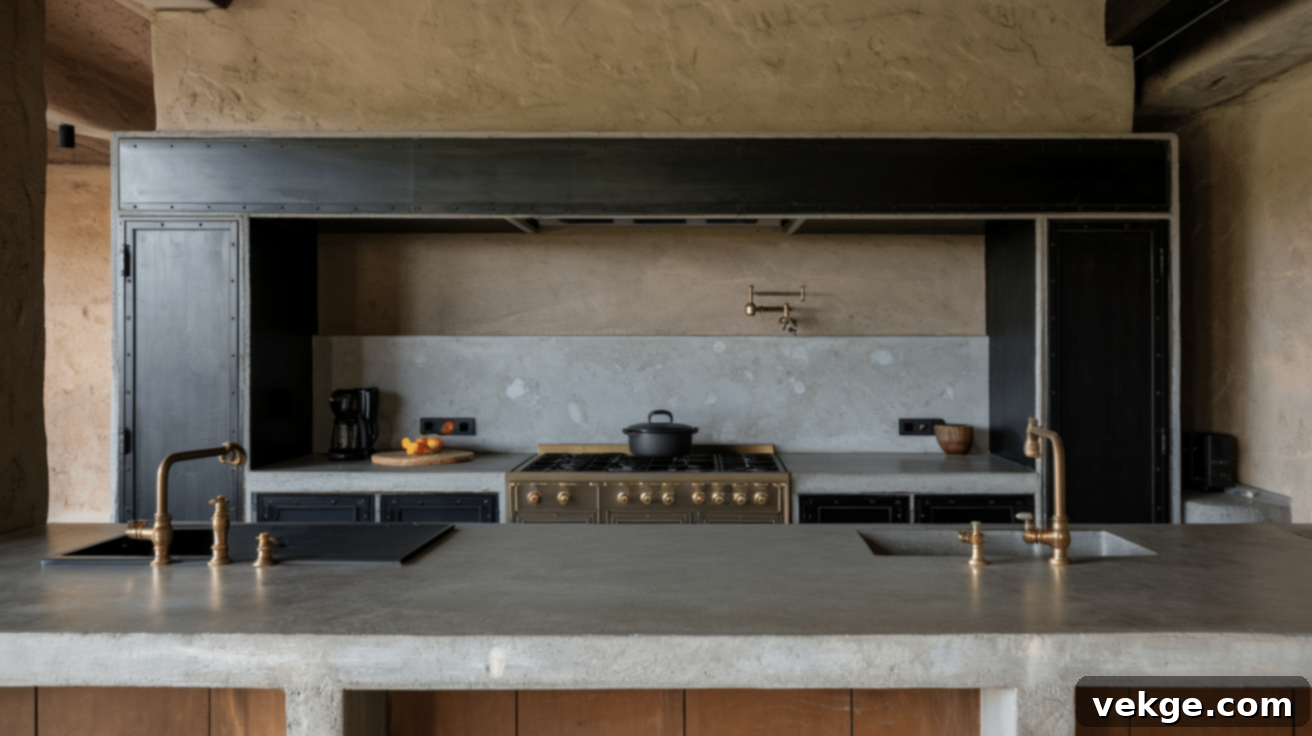
Your journey into brutalist kitchen design begins with the careful selection of materials. Opt for raw, unadorned elements like exposed concrete, natural stone, and various metals. These materials are the cornerstone of the brutalist aesthetic, providing the strong, industrial, and inherently honest feel for which the style is renowned. Consider concrete countertops, which offer durability and a versatile surface, or textured stone backsplashes that add depth and organic character. Matte finishes for all surfaces are preferred as they enhance the ruggedness and tactile quality of the materials.
For appliances, lighting, and fixtures, explore options in stainless steel, blackened steel, or even brushed brass for a subtle touch of warmth and sophistication. These metals are not only incredibly durable but also contribute to the kitchen’s bold, clean, and utilitarian look. When selecting these materials, focus on their inherent textures and how they interact. A rough concrete wall against a smooth steel cabinet creates a dynamic visual dialogue that is characteristic of brutalism.
To maintain the authentic brutalist style, it is crucial to adhere to an earthy and neutral color palette. Dominant hues should include various shades of gray, stark blacks, deep browns, and off-whites. These colors naturally reflect the rawness of the chosen materials and contribute to a grounded, solid feeling in the space. It’s essential to avoid introducing too many bright, vibrant, or flashy colors; instead, keep the palette understated and cohesive, allowing the innate beauty and texture of the materials to truly shine and be the primary visual interest.
2. Smart Layout Choices

The layout is fundamental to successfully achieving a brutalist kitchen. The design philosophy emphasizes openness, clarity, and efficiency. Therefore, avoid overcrowding the space with unnecessary cabinetry, decorative elements, or extraneous details. The primary goal is to maintain a sense of simplicity and unobstructed flow. Opt for sleek, minimalist furniture, and consider integrated appliances that blend seamlessly into the cabinetry for a streamlined appearance. A central kitchen island, often conceived as a monolithic block of concrete or stone, is an excellent addition. It provides extensive workspace and ample storage without introducing clutter, serving as a functional anchor in the room.
Open shelving, crafted from thick wood planks, concrete, or metal, is another highly effective design choice for a brutalist kitchen. It helps to keep the space feeling light, airy, and visually expansive while still offering practical storage solutions. When utilizing open shelving, ensure that displayed items are carefully curated and minimal. Focus on a few key pieces that reinforce the style’s utilitarian and unadorned approach, such as simple ceramics, functional glassware, or a well-chosen collection of cookbooks. The unburdened nature of the layout encourages an uncluttered and efficient culinary environment.
3. Blending with Other Styles
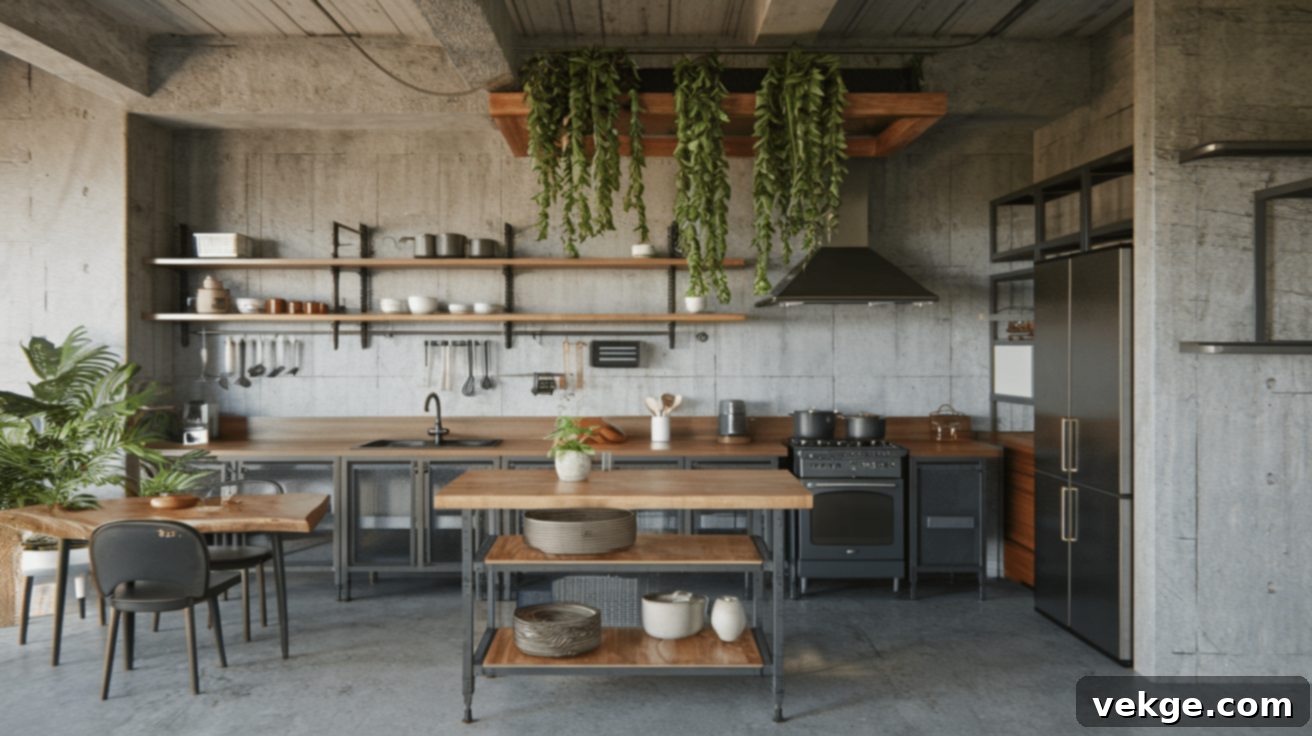
While Brutalism is celebrated for its distinctive industrial and raw aesthetic, its starkness can sometimes be softened to create a more inviting atmosphere without compromising its core identity. This can be achieved by thoughtfully blending it with complementary styles. For instance, if you desire a warmer or more welcoming ambiance, consider incorporating elements from minimalist, mid-century modern, or even bohemian/tropical designs. Wooden accents, such as a substantial wooden island top, exposed timber beams, or floating shelves made from reclaimed wood, can beautifully balance the inherent coolness of concrete and metal, adding organic warmth and texture.
Introducing greenery through plants is another remarkably effective strategy to break up the visual hardness of a brutalist kitchen. Plants infuse life, color, and a sense of natural softness into the space, making it feel significantly more inviting and less austere. You can strategically place small potted herbs or succulents on countertops and open shelves, or incorporate larger, architectural plants by windows or in corners to bring in natural beauty and organic form. The contrast between raw concrete and vibrant foliage is particularly striking and visually appealing.
To summarize, effectively incorporating brutalist design into your kitchen involves a deliberate focus on raw, honest materials, creating a highly functional and uncluttered layout, and selectively adding subtle touches from other styles to soften the industrial edge. By following these steps, you will successfully create a bold, modern, and enduring kitchen that is both incredibly stylish and highly practical, a true reflection of contemporary design principles.
Lighting Ideas for a Brutalist Kitchen

Lighting is an indispensable element in setting the perfect mood and enhancing the raw beauty of a brutalist kitchen. The industrial nature of this style pairs exceptionally well with bold, purposeful lighting fixtures that draw attention to the unadorned materials and clean architectural forms. Here are some compelling lighting ideas to illuminate and define your brutalist kitchen:
- Track Lighting: Utilize adjustable track lighting systems to provide flexible and focused illumination. This allows you to highlight specific areas such as concrete countertops, a textured backsplash, or even a piece of art, all while maintaining a sleek, unobtrusive design.
- Exposed Bulbs: Embrace the rugged aesthetic with pendant lights or chandeliers featuring exposed bulbs. Edison bulbs, with their warm, visible filaments, are an ideal choice, contributing a vintage industrial charm and a soft, ambient glow that beautifully contrasts with the hard materials.
- Spotlights: Install strategically placed spotlights to create dramatic focal points. Directing light onto a central kitchen island, a feature wall of stone or brick, or a striking architectural element can add depth, dimension, and a sense of theatricality to the room.
- Vintage Inspired Lighting: Seek out metal fixtures with a deliberately worn or distressed finish, such as aged bronze, blackened steel, or galvanized metal. These vintage-inspired pieces, reminiscent of old factory or warehouse lighting, bring an authentic classic industrial touch to the space.
- Under Cabinet Lighting: Incorporate practical LED strip lighting beneath upper cabinets or open shelves. This provides essential task lighting for food preparation areas and also creates a modern, ambient glow that highlights the textures of the backsplash and countertops.
- Wall Sconces: Introduce wall sconces, particularly those with exposed bulbs or simple metal shades, to offer a softer, more diffused light. Placed strategically, they can balance the starkness of raw materials and add an architectural element, providing indirect illumination.
- Floor Lamps: Integrate tall, sculptural floor lamps, especially those with metal shades or minimalist designs. These can add both ambient light and a strong vertical structure, fitting seamlessly with the bold, often angular brutalist aesthetic.
- Dimmer Switches: Install dimmer switches for all your lighting circuits. This crucial feature allows you to adjust the intensity of the light, transitioning effortlessly from bright task lighting for cooking to a more subdued, atmospheric glow for entertaining or relaxation, enhancing the versatility of the space.
By thoughtfully layering these diverse lighting options, you can create a dynamic and inviting atmosphere that not only illuminates your brutalist kitchen but also significantly enhances the raw, unpolished beauty of its design elements.
Examples of Brutalist Kitchen Designs
To truly grasp the versatility of brutalist design, let’s explore five inspiring kitchen ideas that skillfully blend its raw, industrial core with elements that bring balance and warmth, without losing its commanding presence.
1. Concrete Meets Tropical Warmth

Imagine pairing the inherent coolness and robust texture of raw concrete countertops with the vibrant, organic life of tropical plants or abundant greenery. The stark, solid feel of the concrete creates a compelling visual and tactile contrast with the bright, lively foliage. This juxtaposition prevents the space from feeling sterile, injecting a refreshing vitality. Further softening the industrial edge, consider adding carefully selected wooden elements, such as richly textured floating shelves, a warm wooden dining table, or a substantial timber island top. These additions introduce organic warmth, helping to create a beautifully balanced and inviting brutalist aesthetic.
2. Industrial Exposed Beams
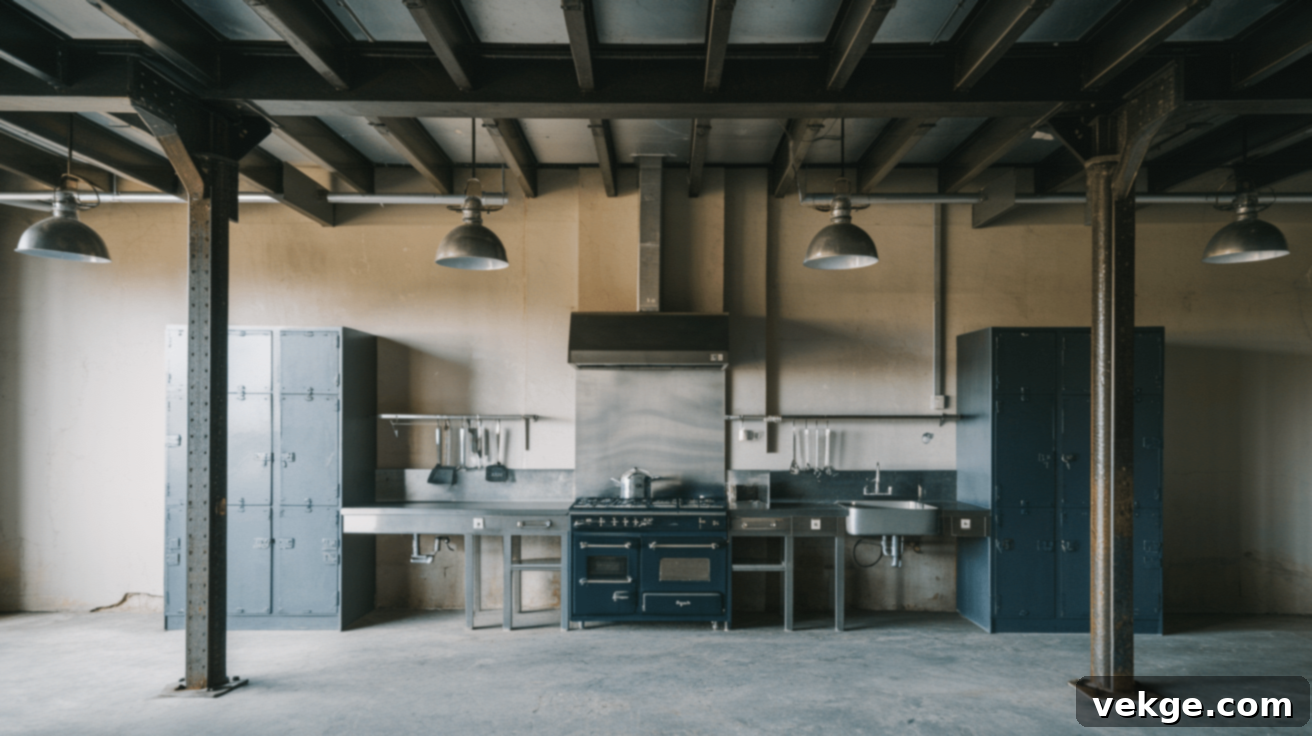
Elevate your kitchen’s ceiling by showcasing exposed structural beams, whether they are rugged wooden trusses or sleek steel I-beams. These architectural elements are a hallmark of industrial design and instantly impart a strong, authentic brutalist vibe to the space. Their visible presence speaks to the honesty of construction, a core brutalist principle. To maintain design coherence, combine these commanding overhead features with simple, unadorned cabinetry and minimalist metal lighting fixtures. This approach ensures the overall design remains clean, rugged, and powerfully cohesive, celebrating the structure itself.
3. Stone Walls with Concrete Touches
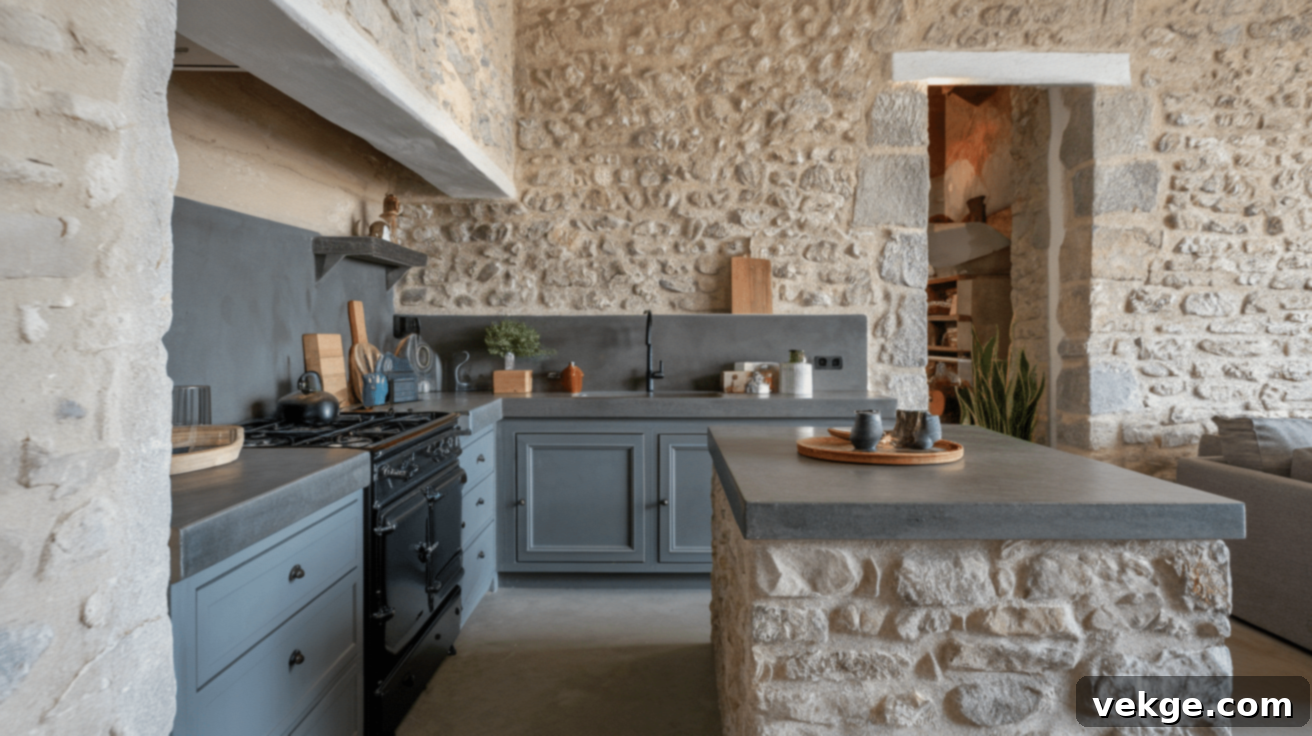
Introduce the timeless texture and organic character of natural stone or exposed brick walls into your kitchen, masterfully juxtaposing them with the smooth yet rugged feel of concrete countertops. The inherent rough texture and varied tones of stone or brick add significant depth, visual interest, and a sense of grounding to the space, creating a rich tactile experience. Meanwhile, the concrete elements maintain a sense of practical utility and modern sturdiness. To achieve a perfectly balanced and cohesive look, consistently stick to a neutral color palette of grays, earthy browns, and muted tones throughout the kitchen, allowing the natural materials to speak volumes.
4. Bold Lighting Fixtures

In a brutalist kitchen, lighting fixtures are more than just functional; they are striking artistic statements. Choose oversized, dramatic lighting elements such as grand industrial pendant lights, sculptural exposed bulb chandeliers, or robust track lighting systems. These fixtures not only provide essential illumination but also introduce a powerful architectural element that perfectly complements the brutalist style’s emphasis on strong forms. Consider large, commanding lights that draw the eye, or unique wall-mounted lamps that contribute to a dynamic and visually engaging atmosphere, underscoring the raw aesthetics of the space.
5. Sleek Minimalist Cabinets with Open Shelving
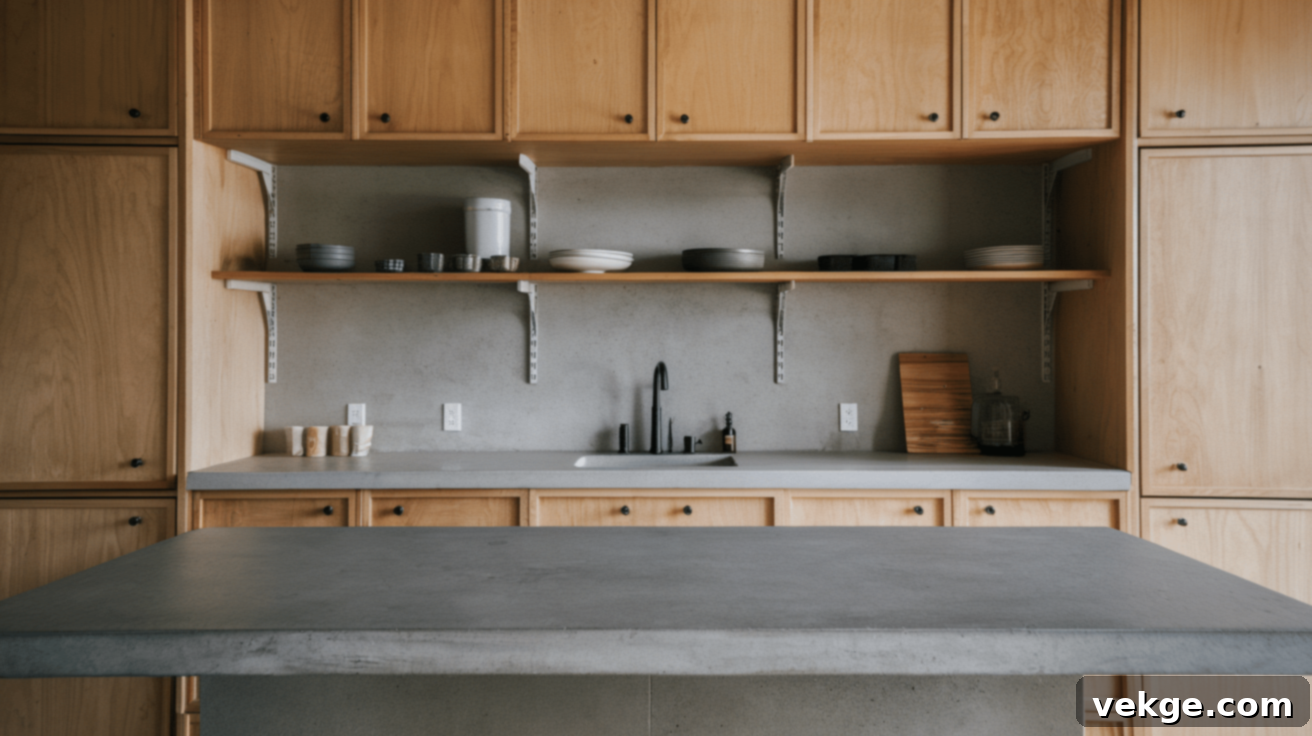
Embrace a design philosophy of simplicity by opting for sleek, blocky cabinets characterized by clean lines and an utter absence of superfluous details. These minimalist units, often in matte finishes of grey, black, or natural wood, create a refined backdrop. Complement this by integrating open shelving, which helps to maintain an open, airy, and expansive feel throughout the kitchen. You can choose sturdy metal shelves for a direct industrial touch or elegant wooden floating shelves to introduce warmth. The key is to keep the shelves organized with minimal, functional items, ensuring the kitchen remains uncluttered and highlights the beauty of the materials themselves.
These detailed ideas will empower you to create a brutalist kitchen that is both exceptionally functional and imbued with profound character, celebrating the raw beauty and strength of modern design.
Tips for a Budget-Friendly Brutalist Kitchen
Achieving the bold, industrial, and raw aesthetic of a brutalist kitchen doesn’t necessarily require an exorbitant budget. With a bit of creativity and strategic planning, you can capture the essence of Brutalism without overspending. Here are some smart, budget-friendly ideas to help you craft your brutalist dream kitchen:
- Laminate Countertops: Instead of solid concrete or stone, opt for high-quality laminate countertops that convincingly mimic the look and texture of concrete or natural stone. Modern laminates offer a wide array of realistic patterns and finishes at a significantly lower cost, providing a similar visual impact.
- Reclaimed Materials: To infuse an authentic, raw, and eco-friendly feel, actively source secondhand or reclaimed materials. Look for sturdy pieces of wood for shelving or a rustic island top, and salvaged metal from architectural salvage yards, thrift stores, or online marketplaces like Facebook Marketplace and Craigslist. These often come with a rich patina that enhances the brutalist aesthetic.
- Painted Cabinets: To replicate the minimalist and often monochromatic vibe of brutalism, undertake DIY cabinet painting projects. Choose matte black, deep charcoal gray, or even a concrete-effect paint to transform existing cabinets. Simple, clean hardware (or no hardware at all) will complete the look.
- Affordable Industrial Fixtures: Scour home improvement stores, discount retailers, and online shops for industrial-style light fixtures and hardware that are budget-friendly. Look for exposed bulb pendants, simple metal cages, or basic track lighting that evoke the brutalist aesthetic without the high price tag.
- Concrete Lookalikes: If real concrete flooring or walls are too costly or heavy, explore concrete-look vinyl flooring, large format porcelain tiles with a concrete finish, or even concrete-effect paint or wallpaper. These alternatives offer the desired industrial impact without the associated expense and installation challenges.
- Open Shelving: Embrace the simplicity and cost-effectiveness of open shelving. Install straightforward metal brackets with raw wood planks or simple MDF painted in a brutalist color scheme. This keeps the space minimal, functional, and significantly cheaper than custom cabinetry.
- Affordable Steel Accents: Achieve the look of expensive steel without the cost. Consider using metal spray paint on existing furniture, accessories, or even cabinet doors to give them a sleek, metallic finish. You can also find affordable thin metal sheets for backsplashes or cabinet fronts.
- Upcycled Items: Repurpose old furniture or industrial pieces for new functions. An old metal filing cabinet can serve as unique kitchen storage or even a rolling island base. Wooden crates can be stacked for open shelving. Give these items a brutalist makeover with paint or by exposing their raw materials.
By implementing these creative and cost-effective strategies, you can successfully bring the raw, functional beauty and distinctive charm of brutalist design into your kitchen space without exceeding your budget.
Maintenance Tips for Concrete and Metal Surfaces
Concrete and metal surfaces are defining characteristics of brutalist kitchens, contributing significantly to their raw and industrial charm. However, to ensure they maintain their striking appearance and longevity, proper care and maintenance are essential. Here’s how to keep your brutalist kitchen elements looking their best:
- Concrete Countertops: Concrete is naturally porous and can be susceptible to staining if left unprotected. It is crucial to seal your concrete countertops regularly with a high-quality, penetrating sealer every 1-2 years. This creates a protective barrier against moisture, stains, and general wear. For daily cleaning, use a mild, pH-neutral soap and warm water with a soft cloth. Avoid harsh chemical cleaners, abrasive scrubbers, or acidic substances (like vinegar or lemon juice) that can strip the sealant and etch the surface.
- Metal Fixtures: Different metals require specific care. Stainless steel, common in brutalist kitchens, is prone to showing fingerprints and smudges. Clean stainless steel fixtures with a microfiber cloth, moving in the direction of the metal’s grain, and use a specialized stainless steel cleaner for a streak-free shine. For other metals like blackened steel or brass, consult manufacturer guidelines. To prevent rust on exposed steel, ensure adequate ventilation and wipe dry any moisture promptly. Regular polishing can help maintain the luster of brass and prevent tarnish.
- Avoid Abrasive Scrubbers: Whether cleaning concrete or metal, always avoid using abrasive scrubbers, steel wool, or harsh scouring pads. These can scratch, dull, or otherwise damage the finish of your surfaces, compromising their aesthetic appeal and protective layers. Opt for soft sponges, microfiber cloths, or non-abrasive brushes.
- Prompt Spill Cleanup: Act quickly to wipe up spills, especially acidic liquids such as wine, vinegar, lemon juice, or highly pigmented foods like turmeric or coffee. If left to sit, these substances can stain or etch both concrete and certain metal surfaces, even if they are sealed. A quick response minimizes potential damage.
- Surface Protection: Implement preventative measures to protect your surfaces. Always use trivets or heat-resistant mats under hot pots and pans on concrete countertops to prevent thermal shock and potential cracking or discoloration. Use cutting boards for food preparation to avoid scratches. For metal surfaces, especially those prone to scratching, consider protective coatings or simply be mindful during use. Avoid cleaners containing bleach on any metal surfaces, as bleach can cause discoloration, pitting, or rust.
With consistent and appropriate care, your concrete and metal surfaces will not only retain their striking industrial charm but will also prove to be durable and beautiful features in your brutalist kitchen for many years to come.
Conclusion
The brutalist kitchen, with its unwavering commitment to raw materials and fundamental design principles, offers an exceptional opportunity to create a space that truly stands apart. By embracing the robust presence of concrete countertops, the sleek resilience of steel fixtures, and the purposeful simplicity of clean lines, you can forge a kitchen that is both profoundly bold and supremely practical. This design philosophy extends beyond mere aesthetics; it’s about crafting a kitchen that functions seamlessly, embodies durability, and powerfully reflects your distinct sense of style.
By diligently following the comprehensive tips and inspiring ideas presented in this guide—from material selection and smart layouts to innovative lighting and budget-friendly solutions—you are well-equipped to transform your kitchen into a brutalist masterpiece. Remember, while the style champions rawness, there’s always room to infuse personal touches, such as strategic greenery or warm wood accents, to subtly soften the industrial vibe and make the space uniquely yours.
Are you ready to embark on your brutalist kitchen design journey? Explore our other blogs for more innovative ideas and expert advice on creating stylish, functional, and truly extraordinary spaces throughout your home.
